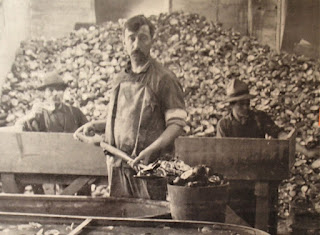In 1887,
 German button maker
John Frederick Boepple (that's him on the right), arrived in the United States and settled in the
Mississippi River town of Muscatine, Iowa. New tariffs on his buttons in
Germany had cut drastically into his profit and he decided to relocated to the
United States. Armed with maps of the rivers of America, he began to search for
new supplies of mussel shells. He found what he was looking for in Muscatine
when he waded into the muddy waters and pulled up a mussel the size of a baby
elephant’s ear.
German button maker
John Frederick Boepple (that's him on the right), arrived in the United States and settled in the
Mississippi River town of Muscatine, Iowa. New tariffs on his buttons in
Germany had cut drastically into his profit and he decided to relocated to the
United States. Armed with maps of the rivers of America, he began to search for
new supplies of mussel shells. He found what he was looking for in Muscatine
when he waded into the muddy waters and pulled up a mussel the size of a baby
elephant’s ear.
Boepple opened a mother-of-pearl button factory in 1891, supplied by an abundance of thick-shelled American pearl mussels from nearby rivers and streams. By 1900, this small Iowa town had earned the right to call itself the "Pearl Button Capital of the World," out-producing more established button-making centers in Europe. By 1905 button makers in Muscatine produced 1.5 billion buttons—almost 40 percent of the buttons produced in the entire world.
They held their
distinction in the world until the plastic button industry undercut them. With the
decline of the button business, most of Muscatine’s mussel fishers began
sending their shell to factories in Japan and other foreign shores where bits
of the shells were turned into nuclei used to seed marine pearl oysters for cultured
pearls. At its height in 1993, the industry exported nearly 7,000 tons of shells.
This region remains the major source of nuclei for use in pearl culturing
worldwide.
On a rather sad side-note, Boepple died of a blood infection
after cutting his heel on a mussel shell while wading in the Mississippi. He
was working with the Fairport Federal Hatchery biological station in Muscatine to
re-seed the rivers and help salvage the marine creatures and the local shell
industry that had long supported this small Iowa river town.
Want to see how a
pearl button is made? Check it out: https://www.youtube.com/watch?v=DI_eyCNj-M0
Tracy



Fascinating! Excellent insight. Glad these amazing creatures are being helped and the rivers re-seeded. Sad about Boepple
ReplyDeleteThanks, Lindsay. My husband said he remembers his grandfathers talking about the mussel harvesting, but didn't realize it was such a big deal.
DeleteA subject I'd never thought about, but who knew it would be so interesting? They must have gone through literally millions of mussels. I wonder what they did with all the meat and the rest of the shells.
ReplyDeleteC.A., they tried feeding the meat to their livestock but it made the pork taste muddy and "nasty." The shells they're still selling to mother-of-pearl factories and pearl culturing to overseas companies.
DeleteFascinating. Just up the river from where I grew up. LOL Doris
ReplyDeleteVery interesting. Long ago, when I was a child, I visited a town farther north on the Mississippi that also made buttons like this. Your blog brings back good memories. Thanks.
ReplyDelete